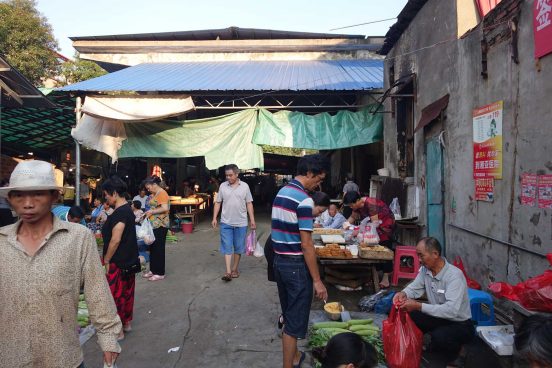Same procedure as every summer, when visiting the in-laws in rural Hunan: We go for a walk through the local market. This time, also fetching spicy breakfast.
Yes, in Hunan, even breakfast can be spicy.
Some of the usual breakfast dishes are rice noodle soups or mi doufu, “rice tofu”, also prepared as a soup. There is usually some pork in those soups, but they get the main flavor from fresh chilli.
I would disagree with the view that Hunan cooking is all too spicy, but the chilli sure is a beloved flavor.
Special Hunan Breakfast Foods
That shows very well in some foods I have only ever found in Hunan.
Many places in China make baozi and rolls made from pretty much the same kind of dough.

Hunan, however, is the only place where I have found a la rou bao, filled with red chilli and pork in a sufficient quantity that, a bit like a Shanghai soup dumpling, there is quite some juice inside.
Only, in the case of those, that juice doesn’t squirt out quite as much, but soaks through the thick dough in a sign of the fat and chilli inside. (That, I did not actually find on the rural market, but added at the end of the video, from our time in Changsha.)
The juan rolls, well. They are normally – read: anywhere else – plain or made with sugar. Hunan does have those, but it also has lajiao juan. Chilli rolls.

The changfen (steamed rice noodle) and mala gan doufu (dried tofu in ma-la flavor), are really not Hunanese, but could be almost anywhere. A bit of the pickles that the changfen are made with, though, thus reflect Hunan eating in their spiciness.
On the Village Market
The market has, with the development of the area towards tourism, had to move to the main road a bit farther away and an area there. (Next time, I wouldn’t be surprised if it were at some modernized market hall, but we’ll see.)
Same as always, it was amazingly diverse.

Greens
Vegetables play a large role, all fresh off the fields. Some are quite certainly from hybrid seed and well-grown, perhaps also treated only too well with modern chemicals. Others may be more literally homegrown; not necessarily for the better.
Either way, the range of greens is always amazing.
And it is quite fascinating to see how some things look like they have probably been like that for centuries, while some other things change quickly.
Soy and Tofu
The soybeans, freshly shelled, are rather traditional. And nearby, one finds tofu sellers which put the shame on anyone who says that they don’t like tofu.
Which tofu? There is fresh tofu that is like a silky pudding, there are tofu strips, there are blocks of harder tofu, there is the tofu that has been prefried for a crispy exterior. All have their uses, all have their differences, at the very least in bite and mouthfeel.
Where the tofu and the soybeans are traditional, the okra is something I had not even seen a year ago, during the last visit. So things change.

Meats
Less of a change among the proteins.
Pork dominates, but there is also beef. And a bit of dog.
Fowl is, as always, as fresh as it can get: It’s all still alive.

Fish
The same with fish, which will even be carried home in a plastic bag with water… and much to my chagrin, I proved myself to not be quite used to China anymore. I turned off the water that was, strangely, flowing into a bucket in the toilet/shower all the time. Never looking inside past the colander on it, I didn’t realize it was for fish. So, I killed the fish before it was its time to be killed and eaten. What a waste.
And Other Edibles Out of the Water
And then, at the market, there are the snails, and frog, and other riches of land and waterways that I can often hardly identify. But that are Hunan in all its agricultural-culinary riches!
Not mentioned so far, but of course everywhere among the vegetables on the market: chilli.
There would be no Hunan cooking without it!

Leave a Reply
You must be logged in to post a comment.